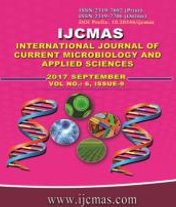


 National Academy of Agricultural Sciences (NAAS)
National Academy of Agricultural Sciences (NAAS)

|
PRINT ISSN : 2319-7692
Online ISSN : 2319-7706 Issues : 12 per year Publisher : Excellent Publishers Email : editorijcmas@gmail.com / submit@ijcmas.com Editor-in-chief: Dr.M.Prakash Index Copernicus ICV 2018: 95.39 NAAS RATING 2020: 5.38 |
The field experiments were conducted in the farmers field under the jurisdiction of the University of Agricultural Sciences (UAS) Raichur during the kharif 2015 and kharif 2016 using randomized complete block design with 7 treatments to determine the effects Land levelling and its temporal variability under different levelling, cultivation practices and irrigation methods for paddy. Contour analysis showed that the number of contours drawn with Surfer Software for 2-cm contour interval for the plots after laser levelling were reduced considerably and the contours were almost parallel in laser land levelling cases. The levelling indices (LI) and range of grid elevations were very small in these cases indicating very high quality and precision of land levelling works with least deterioration of topographic conditions compared to conventional levelling. Whereas, these values were more for conventional levelling due to more number and irregular pattern of contour lines, which revealed poor quality and precision of land levelling as it depended on driver’s judgement. Smaller values of LI indicated higher accuracy of grading in laser levelled fields with evenly levelled topography of land and uniform distribution of water and its storage. There were changes in topographic conditions, levelling quality and precision in terms of levelling indices and range of grid elevations, over the period of study due to the influence of cultivation practices, different land levelling, irrigation methods and climatic conditions. These changes were less as indicated by 75.40 and 87.25 per cent reduction in LI in case of laser levelling methods as compared to 3.27 and 1.73 per cent increase in LI in conventional levelling methods.
 |
 |
 |
 |
 |